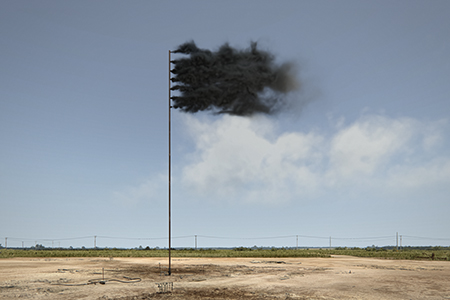Oil. Beauty and Horror in the Petrol Age

No other substance will have shaped societies in the twentieth and early twenty-first centuries as much as oil—countless materials and key technologies, cultural products, ways of life, knowledge, visions, values and emotions, as well as conflicts, injustices, and abysses of our time owe their existence to the energy density and transformability of the ambivalently shimmering “black gold.” Concerns about oil wells running dry are as old as the Petrol Age itself. It is, however, not the finite nature of the resource, but rather the fight against global warming and mountains of plastic waste that is now heralding the dusk of the “Petrol Age.” From a fictional future, the exhibition Oil. Beauty and Horror in the Petrol Age takes a look back at the petromodernism that has lasted roughly 100 years: What is typical of this time, what is great and beautiful, what is ugly and terrible, and how is all this reflected in art and culture?
John Gerrard’s Western Flag (Spindletop, Texas) marks the beginning and end of the petromodern era. His digitally generated black flag poses urgent questions about the reordering of the world while reminding us of the greatest petromodern excesses. Petroleum was the basis of the most important weapons systems of the twentieth century and both world wars. The Byzantines had already directed their Greek fire, a petroleum-based incendiary weapon, at their enemies. With gasoline-based napalm, a combat agent used in the Vietnam War, oil was in turn used as a weapon against human bodies but also against the environment. Wolf Vostell and Martha Rosler refer to this expansion of the combat zone.
The extraction and utilization of oil leaves traces globally: in ecosystems and societies, but also in bodies and souls. The encounter with local cultures and the resulting possibilities and impositions are referred to as “oil encounters.” Ursula Biemann thus sheds light on life along a newly built pipeline. Entang Wiharso addresses the tense relationship between extraction, processing, and consumption in Indonesia. The clash of regional and capitalist interests is revealed by Taryn Simon and Ana Alenso, while Hans Haacke critically questions the patronage of oil companies. Fluctuating oil prices and stock market movements are tracked by Mark Lombardi and Mark Boulos. Romuald Hazoumè refers to precarious trade practices that have established themselves in the local market parallel to the global market.
The euphoria of the Futurists at the beginning of the twentieth century already drew on the new technical achievements of the Petrol Age. Speed and flight became leitmotifs for the representatives of so-called Aeropittura, among whom was Gerado Dottori. Flying thus became the greatest petromodern promise, as William Eggleston demonstrates, while utopias of leaving the planet echo in the works of Michael Najjar. Sylvie Fleury comments ironically on the aeronautical project with a collapsed rocket as a symbol of failed potency and hope.
The smallest but central form of mobilization takes place covertly at the molecular level. It was only in chemical refineries, such as those painted by Carl Grossberg, that fossil natural substances become accelerators of modern culture: fuels, plastics, artificial fertilizers, pharmaceuticals. This modern form of alchemy is the theme of Atelier Van Lieshout’s Naphta Cracker, for example. The technological achievements of petrochemistry have literally made people’s everyday lives more colorful. Claus Goedicke puts the bright colors and organic malleability at the center of his photographs. Tony Cragg’s Menschenmenge (Crowd) refers to a new human species brought about by the Petrol Age, Homo plasticus.
Edward Burtynsky’s photos of the sites of oil production have long been etched into the collective visual memory. An idea of the vertical penetration of the earth’s body is conveyed by Walter de Maria’s Earth Kilometer and Monira al Qadiri’s relentlessly rotating drill head. The use of naturally occurring asphalt goes back to ancient times when it served as mortar in the construction of the Babylonian Processional Way. The ichthyosaur—excavated between Wolfsburg and Braunschweig—places petroleum in the context of a larger natural history.
The exhibition architecture is reminiscent of an archaeological excavation site, allowing a temporal distance to our petroleum-based culture. However, the combination of exhibition walls running diagonally through the hall also represents abstracted layers of earth. Conceptually, the exhibition takes the perspective of a fictional archaeological distance that simultaneously seeks thematic and emotional proximity. It confronts artistic works from the canon of Western modernism, as well as from oil regions around the globe, with objects from natural science and technology, pop culture and everyday life.
The exhibition will be accompanied by a comprehensive publication:
Oil. Beauty and Horror in the Petrol Age edited by Andreas Beitin, Alexander Klose, and Benjamin Steininger, Verlag der Buchhandlung Walther und Franz König, design by Jan Kiesswetter, separate German and English editions, each approx. 400 pages, approx. 450 illustrations, with a foreword by Andreas Beitin, an introduction by Alexander Klose and Benjamin Steininger, and texts by Akintunde Akinleye, Leila Alieva, Dominic Boyer, Jan von Brevern, Heather Davis, Elena Engelbrechter, Christoph Engemann, Timothy Furstnau, Eckhart Gillen, Rüdiger Graf, Helmut Höge, Bernd Hopfengärtner, Isabel Piniella, Karen Pinkus, Christian Schwarke, Suwarno Wisetrotomo, and Susanne Witzgall.
Available for € 39 in the museum shop or at kunstmuseum.de/shop.
Curators: Alexander Klose and Benjamin Steininger from the collective Beauty of Oil, Ralf Beil (2016–2018), and Andreas Beitin (2019–2021)
Curatorial Assistants: Elena Engelbrechter and Regine Epp
The exhibition and publication project is generously sponsored by:
